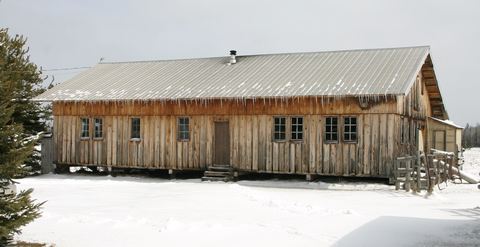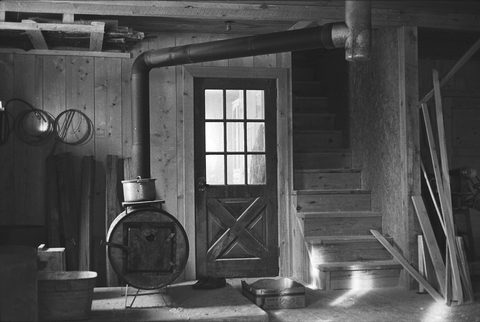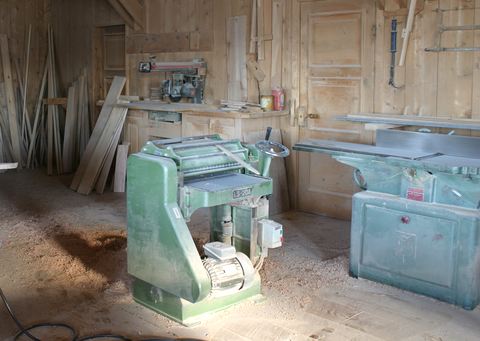My dad's workshop (in 2007)

After moving to Canada, my parents had two businesses which provided the
family's livelihood. One was a tourist camp,
the other one was my dad's custom woodworking business.
 This page describes my dad's workshop. This is actually my dad's second workshop.
The first one burned down 6 years after it was finished. It was not insured. Given the insurance
premiums quoted for insuring a woodworking workshop heated by wood and without dust extraction,
the shop would have had to burn down more than once a decade to make it worth insuring. As it is,
he's now over 25 years in and it has only burned down once, so not getting insurance was the
right thing to do.
This page describes my dad's workshop. This is actually my dad's second workshop.
The first one burned down 6 years after it was finished. It was not insured. Given the insurance
premiums quoted for insuring a woodworking workshop heated by wood and without dust extraction,
the shop would have had to burn down more than once a decade to make it worth insuring. As it is,
he's now over 25 years in and it has only burned down once, so not getting insurance was the
right thing to do.
Heating
 For the second workshop, my dad decided to put the wood stove closer at hand, and right in the shop.
The rationale was that if anything would happen to it, he would notice it before it got out of hand.
This has worked out much better - 20 years running so far.
For the second workshop, my dad decided to put the wood stove closer at hand, and right in the shop.
The rationale was that if anything would happen to it, he would notice it before it got out of hand.
This has worked out much better - 20 years running so far.
The image at left was actually taken back in 1990 by my brother Markus when
we were still playing with black and white film. We haven't taken a photo quite as enchanting
of the old oil-drum woodstove since. The walls around it have also become a bit more cluttered
since then.
 This shot shows the main area where my dad spends much of his time. The low workbench towards the
corner is free from all
sides and is used to assemble most pieces of furniture. The top is 2" thick maple, and its
varnished, so any glue dripped on to it can be scraped off easily.
This shot shows the main area where my dad spends much of his time. The low workbench towards the
corner is free from all
sides and is used to assemble most pieces of furniture. The top is 2" thick maple, and its
varnished, so any glue dripped on to it can be scraped off easily.
Enlarge
Planing and sanding
 In this shot, you can see the 20" thickness planer, 12" jointer, edge sander, and stroke sander.
the sawhorses, in the light towards the right, is where my dad sorts out lumber for a project.
this is where the lumber goes first after he carries it into the shop, and from here it goes over
the jointer and thru the planer for squaring it up.
In this shot, you can see the 20" thickness planer, 12" jointer, edge sander, and stroke sander.
the sawhorses, in the light towards the right, is where my dad sorts out lumber for a project.
this is where the lumber goes first after he carries it into the shop, and from here it goes over
the jointer and thru the planer for squaring it up.
Most of the lumer used to come from
his own sawmill, although he's given up on cutting his own lumber - too old now.
 This shot shows the thickness planer, jointer, and radial arm saw in the background.
The radial arm saw is mostly used for making rough cuts to size the lumber approximately,
as well as shortening scrap wood into firewood. It only has a rough cut blade on it.
Really, a radial arm saw is not rigid enough to make finishing cuts with.
This shot shows the thickness planer, jointer, and radial arm saw in the background.
The radial arm saw is mostly used for making rough cuts to size the lumber approximately,
as well as shortening scrap wood into firewood. It only has a rough cut blade on it.
Really, a radial arm saw is not rigid enough to make finishing cuts with.
The door between the radial arm saw and the jointer goes to a room where the wood shavings go.
to clean up, my dad simply opens the door and pushes the wood shavings into that room.
Farmers and people with horses used to come to retrieve the shavings on occasion. But more
recently, my dad has taken to just shoveling the wood shavings and sawdust straight into
the woodstove.
 This is the lathe. My dad uses it a lot to make drawer knobs and such. Most of his furniture
doesn't use a lot of prominent lathe work, more accents here and there. It's a decent
lathe, but not a super good one.
This is the lathe. My dad uses it a lot to make drawer knobs and such. Most of his furniture
doesn't use a lot of prominent lathe work, more accents here and there. It's a decent
lathe, but not a super good one.
 My dad never got a dust extraction
system for the workshop. I think he figures that sort of
thing is for sissies. Sometimes the air got pretty thick in the workshop from all the wood
dust when he was sanding panels on the stroke sander. Its smoke in the air in this
photo though - my dad had been cutting some wood that caused
a bit of burning in the saw. I guess a bit of smoke hanging in the air is no big deal
to a pipe smoker :) The smoke must be finer particles than the belts ander sawdust, seeing
that it hangs in the air that much longer.
My dad never got a dust extraction
system for the workshop. I think he figures that sort of
thing is for sissies. Sometimes the air got pretty thick in the workshop from all the wood
dust when he was sanding panels on the stroke sander. Its smoke in the air in this
photo though - my dad had been cutting some wood that caused
a bit of burning in the saw. I guess a bit of smoke hanging in the air is no big deal
to a pipe smoker :) The smoke must be finer particles than the belts ander sawdust, seeing
that it hangs in the air that much longer.
Here's a panorama shot of the whole workshop (click to enlarge)

Visible in this one is the 18" band saw. That saw would be good for resawing, but my I have
never seen my dad use it much for that. When I still lived at home, I'd use it quite often
to resaw pieces of usable lumber from cedar slabs from my dad's
sawmill.
I used these to make lawn chairs (similar design to these) which I sold.

 This page describes my dad's workshop. This is actually my dad's second workshop.
The first one burned down 6 years after it was finished. It was not insured. Given the insurance
premiums quoted for insuring a woodworking workshop heated by wood and without dust extraction,
the shop would have had to burn down more than once a decade to make it worth insuring. As it is,
he's now over 25 years in and it has only burned down once, so not getting insurance was the
right thing to do.
This page describes my dad's workshop. This is actually my dad's second workshop.
The first one burned down 6 years after it was finished. It was not insured. Given the insurance
premiums quoted for insuring a woodworking workshop heated by wood and without dust extraction,
the shop would have had to burn down more than once a decade to make it worth insuring. As it is,
he's now over 25 years in and it has only burned down once, so not getting insurance was the
right thing to do.

 For the second workshop, my dad decided to put the wood stove closer at hand, and right in the shop.
The rationale was that if anything would happen to it, he would notice it before it got out of hand.
This has worked out much better - 20 years running so far.
For the second workshop, my dad decided to put the wood stove closer at hand, and right in the shop.
The rationale was that if anything would happen to it, he would notice it before it got out of hand.
This has worked out much better - 20 years running so far.

 In this shot, you can see the 20" thickness planer, 12" jointer, edge sander, and stroke sander.
the sawhorses, in the light towards the right, is where my dad sorts out lumber for a project.
this is where the lumber goes first after he carries it into the shop, and from here it goes over
the jointer and thru the planer for squaring it up.
In this shot, you can see the 20" thickness planer, 12" jointer, edge sander, and stroke sander.
the sawhorses, in the light towards the right, is where my dad sorts out lumber for a project.
this is where the lumber goes first after he carries it into the shop, and from here it goes over
the jointer and thru the planer for squaring it up.
 This shot shows the thickness planer, jointer, and radial arm saw in the background.
The radial arm saw is mostly used for making rough cuts to size the lumber approximately,
as well as shortening scrap wood into firewood. It only has a rough cut blade on it.
Really, a radial arm saw is not rigid enough to make finishing cuts with.
This shot shows the thickness planer, jointer, and radial arm saw in the background.
The radial arm saw is mostly used for making rough cuts to size the lumber approximately,
as well as shortening scrap wood into firewood. It only has a rough cut blade on it.
Really, a radial arm saw is not rigid enough to make finishing cuts with.
 This is the lathe. My dad uses it a lot to make drawer knobs and such. Most of his furniture
doesn't use a lot of prominent lathe work, more accents here and there. It's a decent
lathe, but not a super good one.
This is the lathe. My dad uses it a lot to make drawer knobs and such. Most of his furniture
doesn't use a lot of prominent lathe work, more accents here and there. It's a decent
lathe, but not a super good one.
 My dad never got a
My dad never got a 